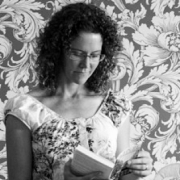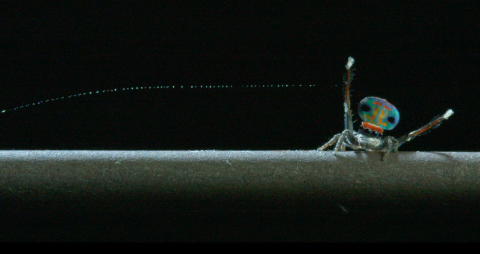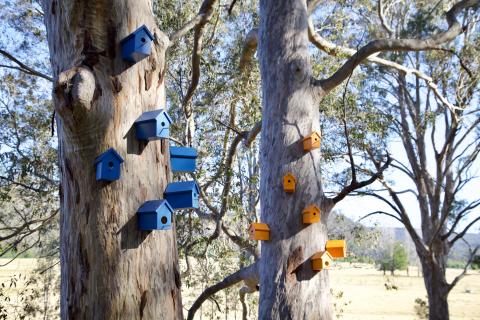Review: New Romance: art and the post human, curated by Anna Davis.
The New Romance exhibition at the Museum of Contemporary Art, Sydney, reminds us of the difference between nature and ecology, between the curatorial brief and the artworks. In other words, it charts the distance between the idea versus the reality, between the object and the thing. In each case, the former is the concept and the latter is the material substance. Many of the artworks in the exhibition look to environmental and new technology issues of hybridity, dark ecologies, robotic ‘other’ and evolutionary futures. These dystopic issues are not new: they sprawl across all areas of art theory and practice like the purplish dust of Paterson’s Curse.
The exhibition title, New Romance, is a word-play based on the tricky Korean translation of the cyberpunk term, Neuromancer, born from William Gibson’s novel of the same title, which follows the story of a washed-up computer hacker. This mistranslation is a lovely segue between Australia and Korea, the two countries that offer up the riches for this show. However, the Speculative Realism aesthetics that have fuelled Neo-romancer art-theory and theory-fiction are not articulated in the exhibition, nor in any web site text. And what is the general public to make of these too-subtle associations linking thing-theory, post-finitude and art? Is this another exclusive exhibition for those in the know?
Speculative Realism is a realm of thought that moves outside the limits of being mortal. If we can only understand the world through a human lens, then we cannot gain access to any other lens, be it non-human or non-earthly. A perception of ‘being’ that considers life, without humans at its centre, might have to turn to philosophy and science fiction, to generate ways of communicating these prickly ideas. Why? Because all other roads of reason are blocked. Imagining an existence outside the human has to be speculative and has to sit outside conventions of chronological time. That is how we find ourselves looking at art works that are robotic hybrids (Marynowsky’s work), alternative species (Piccinini’s work) and evolutionary futurism (Moon and Jeon’s work). I don’t think it would have compromised the exhibition for the curator to have explained this to the audience.
Most of the works in New Romance fit into the theoretical realm of post-finitude, a framework that is at odds with conventions of Romanticism. In a post-finitude or post-human world, how can we make sense of a world that is not human, if we don’t know anything beyond the human? Well, with a sense of unease and dread. Hence, sci fi. If we are living in times haunted by the end of life and in constant dread of extinction, then this is clearly articulated in Hayden Fowler’s cautionary Dark Ecology, a geodesic futuristic structure in clinical white. An oversized igloo, it sits outside the entrance of the Museum of Contemporary Art, Sydney, and beckons the viewer inside to view a mise-en-scene stage of apocalyptic fear. Inside the dome, there is fallen dead tree and a creek overcome with sediment water, more like concrete than clay slip. Behind the dead tree is a cave where many antlers are piled up in a pyre, with not a single biotic being in sight. This is the after-life. This is future dystopia.
Theorist Timothy Morton has been working with the term ‘dark ecology’ for many years now. It is the title of his most recent 2016 book, which bears the subtitle ‘For a Logic of Future Co-existence.’ Morton consistently presents the idea as an extension of an ‘ecology without nature’. This is a strident reaction against Romantic notions of nature as Terra Mater (mother nature), of nature as background entity or as backdrop to human life. In other words, humans might not be thinking of nature. Nature might be thinking us. This philosophical position refers to the idea that humans have been very preoccupied with our own importance and exceptionalism. This, Morton suggests, constitutes a grim mistake. Nature is a construct of our minds, ecology is the real thing. Artist Fowler expertly represents this distinction in his anti-Romantic geodesic dome of decay.
It is interesting that there is a curatorial reference to the artists as ‘inventors’ or ‘mad scientists’ in the online exhibition material. This is an allusion to a conflicting theory, Modernism, where the artists are geniuses, teetering on insanity. Contrarily, most of the works in New Romance elevate more complex issues of aggregated being, of non-specific collective creativity rather than individual Modernist relevance. A perfect example of this collaborative mode of creating art is The End of the World by Korean artists Kyungwon Moon and Joonho Jeon, a two-channel digital video, compelling in its cinematography, costume design, slow narrative arc and speculative fictional modality. The characters on each screen duck and weave, demanding equal scrutiny, as part of a climate-spoiled investigation of what might be left after a catastrophe – a laboratory and a darkened abandoned domestic scene. These last figures may be the only citizens left in the post-sovereign world. For me, the video artwork asked: what happens to collective will and political drive, if there is no society left?
The remaining Korean and Australian artists include Patricia Piccinini/Peter Hennessey, Kibong Rhee, Justin Shoulder, Airan Kang, Stelarc/Nina Sellars, Rebecca Baumann, Soyo Lee, Wade Marynowsky, Sanghyun Lee, Giselle Stanborough, Ian Burns, Siyon Jin and Wonbin Yang. Overall the works in the exhibition are strong but the curatorial thread, as happens so often, is only clear to the curator and a handful more. I can see the connections between her theoretical readings and the artists she has selected but it is very difficult to bridge the gap between complex philosophy and every-day concepts of existence in a curatorial mode. Many of the ideas get lost in translation, much like the exhibition title itself.

-itok=uW9quDPK.jpg)
-itok=4ILe4sjp.jpg)
-itok=Gt_QT576.jpg)
-itok=Egps4vS1.jpg)
-itok=W6lakEzj.jpg)
-itok=a9y3W_TF.jpg)
-itok=QDJLIZ8n.jpg)


